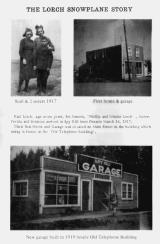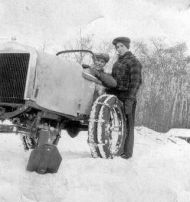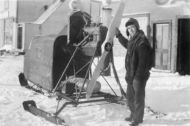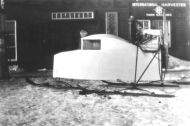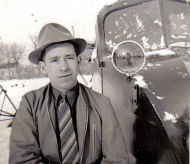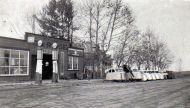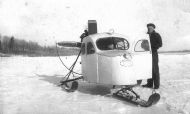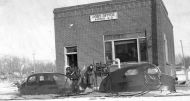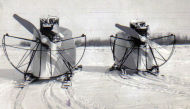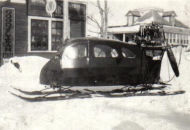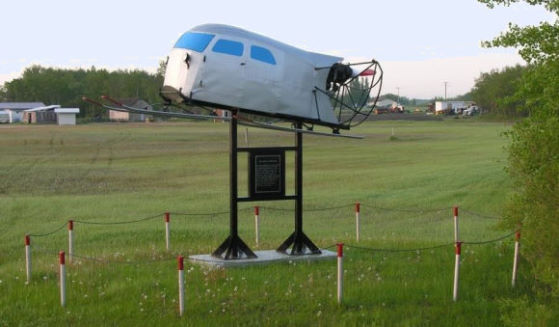 | |
|
Home Centennial Celebrations Businesses Facilities Residential Organizations Spy Hill Park Regional Park RM of Spy Hill History Links Contact  The story of the Lorch Snowplane |
The story of the Lorch Snowplane
The ingenuity of a young local mechanic made Spy Hill known in every province of Canada, in the northern United States and even in the distant Soviet Russia. It was the invention of the Lorch Snowplane which, for many people, revolutionized winter transportation at that period. At a time when there were few graded roads and no snow removal equipment, the first heavy winter snowfall practically put an end to reliable transportation by automobile in this area. Realizing the need for a better means of winter travel than by horse and sleigh, Karl E. Lorch, a young man working in his fatherís garage in Spy Hill, began to develop an idea he had toyed with for some time. His first attempt was made about 1928. With the help of a young farm boy, George Thorpe, he converted a Model T Ford by narrowing the gauge to sleigh width and shortening the wheelbase. The front wheels were removed and bolted to the rear wheels for dual traction, and two metal runners installed in front. Although this machine was able to negotiate sleigh trails, it was very rough, carried only two passengers and its speed was very limited. The machine worked, but Karl was not satisfied. One day, while visiting near an airport, he watched a ski-equipped aircraft land and glide up to the hanger. The sight sparked the idea Karl needed: the Lorch Snowplane was in the making. An engine was taken from a late model car and mounted on a welded steel frame. A five-foot propeller was fashioned from birch wood and bolted to the crankshaft. A single runner was attached in front to steer the machine, while two more runners in the rear completed the running surface of the plane. The gas tank and battery were on a platform under the engine. A trial run satisfied the inventor that his idea was sound, but improvements continued to be made. Aircraft material was used for the body and it was driven by a Model A Ford engine. In later years, aircraft engines were used exclusively. Various pitches and length of propellers were experimented with, as were safer breaking systems, heating, and improved comfort of the cab. The result was a reliable driven model of graceful, streamlined design. Its speed was dependent on snow conditions. While the plant at Spy Hill continued in production, Mr. Lorch also built Snowplanes at Wolford, North Dakota, for about three years. To meet the somewhat different road conditions in that area, Karl developed a more sophisticated model, a wheel combination which enabled the vehicle to traverse longer stretches of bare ground without difficulty. The hydraulically operated wheels were controlled from the operatorís seat by a small lever, the engine supplying the power for changing from wheels to skis, or vice versa. The interior was fully lined like a modern car; was equipped with heater, glass windshield, with electric defroster, instrument panel, seats to accommodate four passengers, brakes were operated by foot and automotive type steering. The vehicle was patented in Canada and the USA. As the fame of the Lorch Snowplane spread, inquiries came from near and far, even from the Department of Transport in the Soviet Union. Many Snowplanes were sold to doctors, taxi services, the RCAF, the Saskatchewan and Manitoba governments as well as to the general public, throughout Canada and the Northern USA. One Snowplane was always kept in readiness both day and night for local use, for the doctor, schoolteachers, sick persons and also expectant mothers. Many trips were made by Karl's father Philip, Karl, and the garage employees -- sometimes in very inclement weather and over bad roads. Dr. Gilbart in a tribute to Phil Lorch, which was read at his funeral service, told of how during his many years of medical practice he had been driven by Mr. Lorch in all kinds of weather, over all kinds of roads, regardless of the hour at which the call came. The industry gave employment to a number of local people, especially during the winter months. Most of the propellers were produced by Karlís brother-in-law, Arnold Sims. Karl Lorch and his Snowplane are an integral part of the history of Spy Hill.
Thank you to Wayne Lorch of Performance Marine in Regina (Karl's son), who provided the booklet and photos for this page. |
|
Home | Centennial Celebrations | Businesses | Facilities | Organizations | Spy Hill Park | Regional Park | History Links | Contact Us | The Lorch Snowplane Copyright © Village of Spy Hill. All rights reserved. |
|
